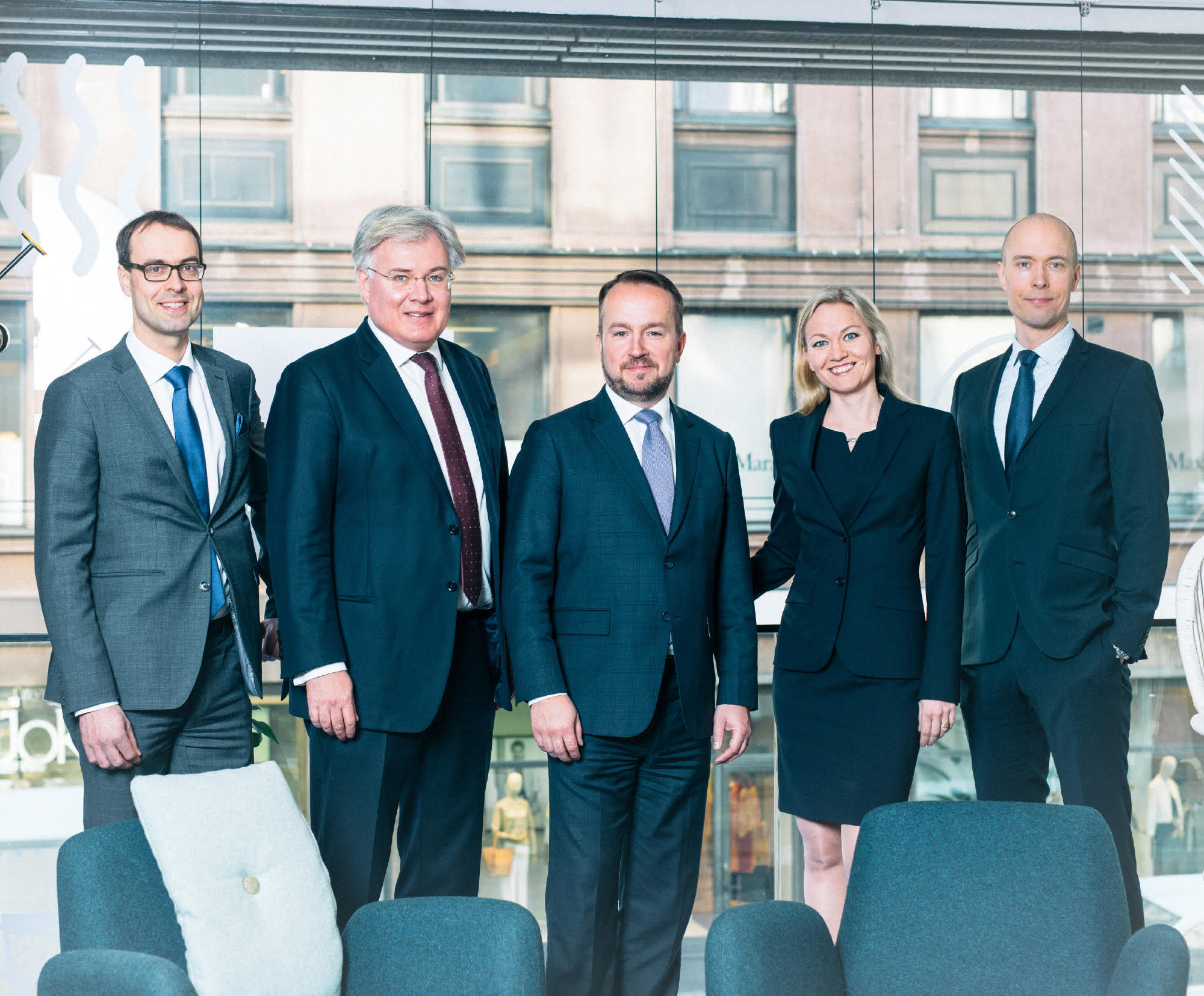
-
EDITORIAL
Ingredients of Value Based Legal Advice
-
INNOVATION POWERHOUSE
Thoughts on Business in the Digital Era
-
SUBSTANCE MATTERS
New Year’s Promise – PSD2 Will Change the World in 2018
-
HAVING BREAKFAST WITH JARNO LIMNÉLL
What’s Happening in the Finnish Data Security Field?
-
RIGHT NOW
The Risky Matter of Data Protection
-
TRANSACTION POWERHOUSE
Tools for Advanced M&A – How to Reduce Uncertainty in Transactions
-
DISPUTE POWERHOUSE
D&I Arbitration Team’s Efforts towards Greater Efficiency in Arbitration
-
RIGHT NOW
#MeToo: How Employers Should React To Reported Sexual Harassment and Inappropriate Behaviour?
-
WE ASKED
What You See I See in 2025
-
THINKING AHEAD
Great Expectations
EDITORIAL
Ingredients of Value Based Legal Advice
I had the opportunity to sit with the chairman of a long-term client of ours at a dinner recently. By the main course we got talking about how increasingly important corporate social responsibility, values and sustainability are for many businesses.
There are some interesting attempts to create new ways of measuring the impact of companies on society and the environment instead of just measuring profitability. Both the chairman and I agreed that the increased focus on the overall impact of companies brings a new and exciting aspect to the evaluation of companies and their success. From there we went on to discuss what this overall development means for our respective businesses.
At D&I we have for a number of years analysed corporate social responsibility and its legal framework. It is clear that corporate social responsibility has a solid basis in Finnish company law and that there is an obligation on board members and management to consider corporate social responsibility issues in their decision-making.
For us, D&I’s corporate social responsibility means things like being a “WWF Green Office”; being a fair, equal and inspiring workplace for all and we as a company being ethical in all we do.
At the same time it is deeply embedded in our firm culture that we want to contribute to causes, which we feel are important, such as protection of the environment, world peace and children in need. Our work for our pro bono partners WWF, CMI, Ronald McDonalds Childrens’ House and the Finnish Hospital Clowns brings a whole different dimension to our workplace and we are very proud to play even a small part in their important work.
But what does the increased focus on values, good corporate citizenship, corporate social responsibility and sustainability mean when it comes to the core of our work, rendering legal advice?
Our aim is always to provide insightful advice – tailored advice to help our client reach its objectives. The advice should not be limited to what is legally acceptable, but rather take into account the client’s situation and the circumstances as a whole. We genuinely try to come up with concrete solutions that are wise, feasible and sustainable for the specific client under the prevailing circumstances.
The challenge is to combine such concrete insightful advice with giving our increasingly value driven customers an understanding of the choices that the client makes if it decides to follow our advice. Our task is not only to give insightful advice and suggest concrete actions, it is also to bring transparency to the underlying choices that the client has to make when choosing their course of action.
Every piece of insightful advice we render entails a number of choices where our client may wish to choose differently, depending on the values that guide its business. Our task is to assist our clients in making those choices deliberately. This is of course easier where we as advisors are aware of the client’s values. The better we know our clients, the easier it is to understand the choices the client wishes to make and not make.
This is yet another reason why we believe that close long-term relationships with clients allow for creating exceptional added value.
Let’s build a better world together by making deliberate choices based on the values we believe in!

Jan Ollila
Senior Partner, Head of M&A & Private Equity
INNOVATION POWERHOUSE
Thoughts on Business in the Digital Era
The tangibility of intangibles is decreasing. Looking at the league tables of the world’s most valuable brands, it is relatively straightforward to appreciate that value is more and more attributable to data, information and knowledge. For many, the value of traditional intellectual property is, if not decreasing, at least being diluted by the other closely related intangible assets.
“Why gather data and expose a company to severe sanctions e.g. under the GDPR if the data cannot be effectively utilized?”
For companies creating their own data assets for the purposes of commercialization, the ability to dispose and make use of their data is fundamental. Typically that can to a great extend be achieved through a fairly straightforward clause included in the user agreements. However, more of often than not it is established that such a simple element has been overlooked. Why gather data and expose a company to severe sanctions e.g. under the GDPR if the data cannot be effectively utilized?
This is a prime example of the necessity of a well-rounded advice. Although overdoing planning may in some instances be detrimental to a business, acknowledging one’s key assets and ascertaining the effective utilization of the related opportunities is so crucial that it certainly deserves special attention.
Companies relying on data obtained from third parties, on the other hand, are offered various new tools. Not that long ago, customer lists often contained only the most essential pieces of information for contacting a customer like phone number and address. Surely that had certain value. But it is a drastically new game when customers can actually be contacted e.g. at the time of day when their stress levels are known to be at their lowest, relying on information from a third party obtained through wearable sensors monitoring the heart rate variability, or the like, of the representative group.
“Basic things are often lost in translation when dealing with new business drivers”
There is no shortage of guidance regarding how to build a successful data driven business. But it seems that basic things are often lost in translation when dealing with new business drivers. From experience, the simplicity of operating model or the intra-group pricing of soft intangibles often do not receive sufficient attention, which easily results in suboptimal use of the group’s intangible assets or time consuming tax litigations and other administrative processes drawing the attention of the managers away from developing their business.
“If it once was a “strongly recommended” to centralize a group’s intellectual property assets, at the time of modern data assets there should be no doubt”
The components of a streamlined group structure remain largely the same as they were a couple of decades ago when value was perceived to be attributable around traditional intangibles. There are new ingredients though. Much more than what is the case with traditional intellectual property, data is genuinely portable. This represents an opportunity for restructurings and divestments, but at the same time, the fact that it is typically not and cannot be protected through registrations or similar, may also represent a threat. An asset that is not registered in the name of any particular company can easily become decentralized between group companies over time. Is there a better cause for severe transfer pricing dispute? Unless special attention and care is paid to the allocation of intangible assets, overlapping interests will inevitably occur. This is why it is so important to have a clear focus in all matters relating to intangibles. If it once was a “strongly recommended” to centralize a group’s intellectual property assets, at the time of modern data assets there should be no doubt.
“It does not seem reasonable to try to ring-fence the digital economy from the rest of the economy”
The current digital business models link data, algorithms, intellectual property, software and know-how in a seamless and effective way. It is clear that our international tax system was not designed for such purpose, and this has resulted in an unprecedented turmoil regarding tax policy. The EU Commission’s recent communication ”Fair Taxation of the Digital Economy” (September 2017) is a prime example. The OECD does not rest still either. The public comments regarding the Tax Challenges of Digitalization report were published on 25 October 2017. The widely accepted goal of ensuring fair and effective taxation seems indisputable as the digital transformation of the economy accelerates. Also, levying taxes where the profits are generated sounds good.
As all businesses operate in a fundamentally different manner today than at the time the international tax rules were designed, it does not seem reasonable to try to ring-fence the digital economy from the rest of the economy. Further, from a tax practitioner’s standpoint, while the entire international tax system is largely based upon adhering to the arm’s length principle, how could the digital business be taxed differently?
At minimum, it is paramount that any changes introduced to the international tax rules are based on a concerted action at global level and aim at long-term solutions. What comes to digital revolution, we are only at the very beginning and really haven’t seen nothing yet. Regardless of the political momentum, quick fixes for new international tax rules seem therefore likely to create more chaos and confusion than providing building blocks for successful businesses. Once we have an understanding of where the world is going to, the rules need to be revised. But for a while, I would rather sit back and enjoy the show.

Kai Holkeri, Partner, Head of Tax & Structuring on the right
Kai Holkeri
Partner, Head of Tax & Structuring
SUBSTANCE MATTERS
New Year’s Promise – PSD2 Will Change the World in 2018
After a lot of talk on the Second Payment Services Directive (PSD2), it is time for action. 2018 is the year when PSD2 will be transposed into national legislation and revolutionize the insights for payment services in the European Union (EU). While there will be challenges implementing PSD2 in the short term, PSD2 will definitely foster innovation and bring competition in the long term.
PSD2 – What Is It Again?
PSD2 extends the scope of the original Payment Service Directive (PSD1) from 2007. The revised Directive is a response to the market developments and introduces enhancements in consumer protection, promotion of innovation and improvement of security.
PSD2 is relevant to payment service providers (PSPs) such as credit institutions, payment institutions, e-money issuers and their agents as well as many FinTech companies, technology providers, payment card operators and e-commerce marketplaces.
PSD2 regulates also two new types of PSPs: payment initiation service providers (PISPs) and account information service providers (AISPs). The key issue in this respect is that PSD2 requires banks to provide access to their customers’ bank accounts to PISPs and AISPs – provided that the customers have given their explicit consent thereto. This requirement is fostering a more open financial sector, also known as open banking, which is said to eventually change the banking as we know it.
Some specific changes compared to PSD1 include the extension of regulation to all currencies and one-leg payment transactions, changes to the scope of exclusions (for example commercial agent exemption and telecoms exemption are narrowed) and requirements regarding operational and security risk management and incident reporting. In addition, PSD2 introduces stronger customer protection measures such as restrictions on surcharges and reduced cap (EUR 50) on liability for unauthorized transactions. Requirements for strong customer authentication and secure communication should be mentioned as well.
Where Are We Now?
PSD2 must be transposed into national law by 13 January 2018, and the majority of the legal provisions will apply from that date. However, not all is clear after PSD2 has been locally transposed. PSD2 empowers the European Banking Authority (EBA) to develop a number of guidelines and technical standards, including regulatory technical standards (RTS) on strong customer authentication (SCA) and secure communication, applicable 18 months after its publication in the Official Journal of the EU. As this RTS became a dispute between the EBA and the European Commission, the RTS was adopted by the European Commission only in late November 2017. Subject to the agreement of the Council and the European Parliament, the RTS is now expected to become applicable around September 2019.
“There will be an interesting period between the implementation of PSD2 and application of the SCA RTS”
Needless to say, there will be an interesting period between 13 January 2018 and the date when the SCA RTS will be enforced. During this transitional period, banks are supposed to comply with PSD2, but are not yet obliged to implement the new security measures specified by the RTS. Different standards and data formats may therefore be expected. On the other hand, forward thinking banks have already started to operate under an open banking environment using open application programming interfaces (APIs) to meet the PSD2 requirements.
Towards the Future – and PSD3?
Thinking ahead, PSD2 will open up the banking system to new innovations that weren’t possible before and improve applications that exist today. As payments at the same time become integrated and invisible part of consuming, we will be introduced a totally different way of living. Accordingly, it is not only banking that is changing. The whole world is subject to change because of PSD2.
“As the digital age has only just begun, we should not be surprised to see a PSD3 initiative”
This change will most likely mean more regulation. Accordingly, by the time we have gotten used to PSD2 (and finally also standards set by the SCA RTS), we should not be surprised to see a PSD3 initiative. This is because the aim of the payment service regulation is to make the EU fit for the digital age – and the digital age has only just begun.
Preparing for PSD2 in Finland
PSD2 is implemented in two parts in Finland, by amending the Payment Services Act and the Payment Institutions Act. Legislative proposals were published in October 2017 and submitted to Parliament’s plenary session in November 2017. Final legislation relating to PSD2 is intended to enter in force on 13 January 2018.
"Prepare for PSD2 by checking your authorization and updating relevant contract terms."
PSPs operating in Finland should consider the potential impacts of PSD2 on all aspects of their business operations. This does not apply only to banks. From a legal perspective, at least the following should be noted by many PSPs in order to comply with PSD2:
1Check your authorization.
PISPs need to apply for authorization and AISPs register with the Finnish Financial Supervisory Authority (FIVA). Currently regulated PSPs will have to demonstrate to FIVA that they comply with PSD2 including new operational and security requirements, as applicable. Different transition periods apply to different PSPs in this respect.
2Review contract terms and update procedures.
PSD2 includes provisions that will need to be reflected e.g. in customer terms and conditions and marketing materials. On the other hand, complaint handling and alternative dispute resolution procedures need to be updated and fraud, security and risk management as well as reporting policies reviewed.
3Create a regulatory strategy.
The European and national authorities provide further clarification and guidance relating to PSD2. FIVA has even established an open follow-up group relating to the transposition of PSD2. To take advantage of PSD2, prepare a plan how you keep yourself updated on new provisions and challenge yourself to understand also the interaction of different regulations. You may begin your regulatory journey by analyzing PSD2 and General Data Protection Regulation GDPR as both will be relevant in terms of customer data and customer consents in 2018, but from different perspectives.

Hanna-Mari Manninen
Partner, Co-head of Finance & Capital Markets
@hm_manninen
HAVING BREAKFAST WITH JARNO LIMNÉLL
What’s Happening in the Finnish Data Security Field?
Our partner Jukka Lång had an insightful breakfast with one of the indisputably best experts in data security matters in Finland, Mr Jarno Limnéll. They both agreed that in the rapidly evolving cyber security landscape, regulating or preventing yesterday’s threats is not worth the effort. One must think ahead.

The Growing Interest in Data Protection and Security
The general interest in data security and data protection has rapidly increased. Both the technical capabilities and regulatory requirements have increased, and so has the general public’s interest.
Data security and personal data protection go hand in hand, as Mr Limnéll pointed out. For many, these two mean the same thing, but from both the practical and legal perspective, there is a difference between these concepts. In practice, data security covers the methods used for protecting the data from illegitimate access. Data protection, on the other hand, means defining how personal data may be accessed lawfully and by who.
Both Lång and Limnéll see that the general interest in data protection and data security is continually increasing. This development is surely fuelled by the clearer picture on the cyber security landscape we are going to have next spring. Previously, many of the cyber security incidents stayed under the radar. The knowledge on cyber security and the level of data protection will increase next spring, when the GDPR, with the notification obligations, enters into effect. The GDPR obligates companies that process personal data to inform the authorities and, in some cases, customers within 72 hours of becoming aware of a data breach. Already sending marketing material to recipients in the "Cc" field revealing all the emails or a ransomware attack could trigger the notification obligation. This will have an effect on companies’ obligations, but also bring many issues that could currently be kept secret into public knowledge.
Legal Data Security Requirements are Fragmented but Share a Uniform Approach
Every day, more and more data is being stored, and that data must be protected. Data protection - and data security to some extent - is somewhat strictly regulated. In the fall of 2016, D&I assisted the Ministry of Transport and Communications in the preliminary preparation of the national implementation of the NIS directive, which will boost the level of cybersecurity in the EU and have an effect especially on the most essential sectors, such as electricity and transportation. We assessed and analysed what types of data security, risk management and other security obligations are set forth in the Finnish law, EU-law and treaties currently applicable to the sectors covered by the directive. What we found, amongst other things, is that the security and risk management obligations fragmented and spread across our legislation. For example, if you are in the finance sector and your data assets are attacked, you may need to inform several authorities, while minimising the damages and be able to prove that you did your best to protect the data. To be able to comply with the relevant requirements, you need to know which requirements you are subject to.
"The strategic-level and legal assessment of data security from the risk based approach gives the possibility to make more informed decisions"
However fragmented, the different data security-related legal requirements share the similar "risk-based approach", which is especially introduced in the GDPR. This should also be the approach taken by those assessing the requirements and ensuring that agreements, systems and procedures are compliant and contain minimised risks. The strategic-level and legal assessment of data security from the risk based approach gives the possibility to make more informed decisions – and for the individuals to speak a similar language whether they are lawyers, security professionals or management only starting to understand the field of security.
Securing and Protecting the Most Valuable Assets
Whether you define your data assets as the oil or the air, the data flows circulate around every key element of your business, including running machines, HR and CRM. Both Jukka and Mr Limnéll have seen that Finnish companies are increasingly interested in personal data protection and cyber security-related issues and have been advising large Finnish companies, and their top management, in these issues. There are many reasons for that, including the role of the ubiquitous data in the business and the resulting wider PR and regulatory risks, not least because of the high sanctions under the GDPR.
“Cyber security is no longer only IT’s or security consultants’ problem, but rather a matter that concerns the company’s core business”
One of the key aspects in this regard is that cyber security is no longer only IT’s or security consultants’ problem, but rather a matter that concerns the company’s core business. This is nowadays the case regardless of whether the company is a retailer in the consumer business or a metal factory far from data driven business (needless to say, however, many of the factories are also experimenting with the opportunities provided by data driven business models). Data security and data protection are so closely linked to the core business and corporate governance that it is necessary for the management to be informed and to then make the key decisions regarding these matters.

Jukka Lång
Partner, Head Data Protection, Marketing & Consumers
@JukkaLang
Tuomas Haavikko
Associate, Data Protection, Marketing & Consumers and Finance & Capital Markets
@TuomasHaavikko
RIGHT NOW
The Risky Matter of Data Protection
With 6 months to go until the GDPR steps in, it is time to shift your focus from general risk mitigation to risk prioritization.
Know Your Endgame
Identifying, assessing, prioritizing and mitigating data protection risks. That is what GDPR readiness work is all about.
However, with so little time left and so much to get done, it is easy to skip straight to mitigating the risk of administrative sanctions. While this course of actions is certainly necessary, it has two major flaws.
What Risks Can You Live With?
1 Flaw #1: Your ultimate GDPR risk level is determined not by the risks you have taken care of but by those you have yet to tackle. Despite all your hard work, it is highly unlikely that your company can be fully GDPR compliant by 25 May 2018. This leads to the question: what risks can you live with? In order to answer that you have to know what risks you are up against.
2 And so we get to flaw #2: Administrative sanctions may not even be your biggest risk. Think: interruptions to your service, corruption of data, decline in customer trust, inflexible services… these issues may initially appear small but can, in practice, cause large damages to both you and your clients.
Prioritize
This leads us at D&I to believe that instead of mitigating every risk you come across and hoping you have time to fix them all, the key to GDPR success lies in prioritizing your work. Here are a few of the points we tend to focus on:
Key Insights
Risk: Sanctions or client distrust due to insufficient proof of data protection work
Solution: Accountability check list – The GDPR summarized in one word: "accountability". Ensure that you have a clear and thorough step plan on how to get your documents and processes in order so that when your clients or the regulatory authority come knocking on your door you have something to show for your work.
Risk: Damages due to service provider actions or omissions
Solution: Processor management controls – With service providers playing such a key role in the processing of your data, keeping them in check is a top priority. To do that you need data processing terms, processor selection criteria, and audit processes – just to name a few.
Risk: Damages caused by human error
Solution: Awareness training and allocation of responsibilities – Not everyone has to be a data protection expert, but everyone needs to know (a) when to ask questions, (b) and whom to turn to.
Iiris Kivikari
Senior Associate, Data Protection, Marketing & Consumers
@iiriskivikari
TRANSACTION POWERHOUSE
Tools for Advanced M&A – How to Reduce Uncertainty in Transactions
2017 has witnessed strong M&A activity, with year to date figures for Europe showing increase in aggregate deal value compared to both 2015 and 2016. The outlook remains promising with a robust deal pipeline and an abundance of dry powder and strong corporate balance sheets. However, there are significant factors that continue to cause uncertainty for M&A.
TThe nature of deals is changing. Deals are getting bigger and frequently involve complex multi-jurisdictional aspects, the market players are facing increasing pressure to get the deals done in a highly competitive and unpredictable landscape. In addition, the clichéd phrase "every company is a tech company" has interesting implications for transactions; the value of companies more often lies in intangible assets, making the valuation more challenging and expanding the scope of due diligence to complicated issues involving technical, IPR and data privacy matters. Ultimately, all of these factors contribute to the parties in M&A transactions facing growing uncertainty in an increasingly complex world – and we did not even mention the rapidly changing political and regulatory landscape! Against this background, it is vital that all parties involved in M&A make the most of tools which help to reduce uncertainty and enable focus on issues that really matter.
Comfort through M&A Insurance
In broad terms, M&A insurance is a product enabling the buyer and/or the seller to transfer risks related to the transaction to the insurance market. With the help of M&A insurance, the transaction can be structured in a way that typically provides the buyer with less risk and equal or better protection, while the seller achieves the best possible price in combination with an exit with less or no risk or liabilities. The most widely used type of M&A insurance policy is W&I insurance, which insures the seller's representation and warranties, bridging the gap between the parties in M&A negotiations on the potential post-closing erosion of value.
M&A insurance has become an appealing antidote against uncertainty and it has become a fixture on Nordic deals, especially transactions with private equity involvement. M&A insurance brings clarity to the allocation of risk and allows the parties to focus on fundamental questions. Used correctly, M&A insurance means more straightforward transaction processes reducing the time spent in negotiations. As the insurance market evolves, we also expect to see a rise in the use of opinion based insurances against specific known tax or litigation issues, complementing W&I insurance and further expanding the toolbox.
AI – the End of M&A lawyers?
AArtificial intelligence (AI) has been characterized as the most important technology of our time and its revolutionary significance to the mankind is often compared with that of steam engine or electricity. Not surprisingly, AI is already being integrated into M&A processes and can play a vital part in helping the parties to focus on what really matters. In the context of M&A, law firms have adopted AI tools in particular in the work intensive stages of due diligence which have traditionally required hundreds of hours of document review. We at Dittmar & Indrenius have introduced the Luminance® AI platform as a part of our due diligence process in order to better enable us to focus our efforts on providing added value to our clients.
"The rise of AI will highlight the significance of the remaining human factors in the M&A process, making the choice of legal advisor perhaps more essential than ever."
Despite of the inevitable triumph of AI – and perhaps to the regret of some – M&A lawyers are not an endangered species. At least for now, the uses of AI are limited to routine tasks which do not require creativity. While AI is handling more and more routine work in transactions, the lawyers need to focus on increasingly complex issues which call for creativity, judgment and efficient communication. These are all tasks that machines are not very good at, at least not today. Consequently, the rise of AI will highlight the significance of the remaining human factors in the M&A process, making the choice of legal advisor perhaps more essential than ever.
Pablo Picasso once said that computers are useless because they can only give you answers. This observation, while perhaps somewhat exaggerated, provides insight also on the limits of AI. It is a tool for analyzing massive amounts of data and answering specific questions, not for posing them. Lawyers who figure out what problem to tackle next, or what new possibility to explore, will continue to be essential. Paraphrasing the leading AI researchers Erik Brynjolfsson and Andrew McAfee from MIT, over the next decade AI won’t replace lawyers, but lawyers who use AI will replace those who don’t.
Wilhelm Eklund
Partner, Co-Head of M&A & Private Equity
Toni Pöllänen
Associate, M&A & Private Equity and Finance & Capital Markets
DISPUTE POWERHOUSE
D&I Arbitration Team’s Efforts towards Greater Efficiency in Arbitration

Superior knowledge of the law or proficient command of advocacy skills are arguably no longer enough, by themselves, to win complex, multi-layered, document heavy arbitration cases in Finland. There is an increasing demand for arbitration practitioners to ensure cost-efficient and expeditious arbitration process with adept case management techniques and the use of the cutting-edge technology tools.
Moreover, the increasingly international nature of arbitration cases seated in Helsinki not only calls for proficient language skills from the Finnish arbitration practitioners but also understanding of different cultures and laws of different jurisdictions gained through first-hand experience.
This article explores how D&I arbitration team has recently successfully tackled these challenges in its international arbitration cases.
The Increasing Demand for Cost-Efficiency and Expeditious Arbitration Process Calls for Effective Case Management
The lack of efficiency in arbitration process has rightly been identified as a key development area in the field of international arbitration. Many leading arbitration institutions have accordingly made significant efforts towards greater efficiency in the recent amendments to their respective arbitration rules.
D&I Dispute Resolution Playbook codifies case management techniques that are proven to ensure efficient arbitration process and highly favourable results to clients"
The lack of efficiency in arbitration process has rightly been identified as a key development area in the field of international arbitration. Many leading arbitration institutions have accordingly made significant efforts towards greater efficiency in the recent amendments to their respective arbitration rules.
The Arbitration Institute of the Finland Chamber of Commerce (the "FAI") has followed the suit. The FAI Arbitration Rules 2013 (the "FAI Rules") impose an overall good faith obligation on parties and tribunals "to make every effort to contribute to the efficient conduct of the proceedings in order to avoid unnecessary costs and delays." In the spirit of this overall duty, the FAI Rules impose a number of obligations on the arbitral tribunal and the parties that are designed to reduce time and costs of the proceedings, including an obligation on the arbitral tribunal to render the final arbitral award within nine months from the receipt of the final award.
The nine months' time-limit also puts pressure on the parties and their counsel to engage in efficient case management, particularly if two rounds of written pleadings are to be exchanged, full document production exercise is to be undertaken and one or two weeks' of oral hearing is to be conducted followed by the exchange of written post-hearing briefs.
Consequently, the D&I Arbitration team has recently devoted a significant time for the planning and designing of all the more effective and efficient case management techniques. These are described below.
D&I Dispute Resolution Playbook
Among the developments in D&I's case management techniques is a protocol called the 'Playbook' that sets out step-by step detailed specific procedures for the conduct of arbitrations with an aim to make the case management and the overall arbitration process more efficient.
These procedures are not meant to be inflexible rules. Rather, through the Playbook we explore with our clients how such procedures may be applied in each particular case. The use of the Playbook ensures, however, that no time is wasted in reinventing the wheel all over again in each case as it identifies the procedures that have been proven to make the arbitration process efficient and have in the past led to highly favourable results to D&I clients.
The Use of the Cutting-Edge Technology Tools in Arbitration
Another development in D&I's case management techniques is the greater use of the cutting edge artificial intelligence technology tools for document review, oral hearing preparation and creation of interactive electronic submissions, known as e-briefs, with hyperlinks to the relevant exhibits.
These tools make the case review, search for and organisation of the relevant evidentiary documents as well as preparations for the oral hearings expeditious and cost-efficient and enhance the speed and ease of writing and reading of submissions. These tools further involve the client in the production process to a greater extent, enabling the client to follow the counsels' argumentation and give input on the submissions before they are filed.
D&I's International Arbitration Team
The international arbitration cases seated in Helsinki are increasingly international in nature. The FAI has recently reported that 37% of the requests for arbitrations that are filed this year are international in the sense that at least one of the parties is a non-Finnish national.
D&I has prepared for the increasing internationalization of its cases by hiring an international team of lawyers with education and/or substantial first-hand experience from jurisdictions such as England & Wales, Sweden, Switzerland and Portugal. In addition to English, Finnish and Swedish language skills, D&I arbitration team members also speak French, Spanish, Portuguese, Norwegian and Turkish.
Breaking the Silos by Cross-Departmental Team Work
As part of D&I Arbitration team's commitment towards efficiency, D&I further engages in cross-departmental team work to handle its arbitration cases. D&I's arbitration team has recently, for instance, secured a highly favourable victory for its media client in FAI arbitration against Swedish public company and its Finnish subsidiary in a domain name dispute, which involved complex contract, trademark, competition and competition law issues.
We see that to a large extent, the victory in that case was undoubtedly the result of working in a close-knit cross-departmental team involving lawyers from our arbitration, M&A, competition and intellectual property practices. We see that eliminating the silos through D&I's Powerhouse culture presents yet another crucial element in the effective case management.
Most Recently D&I has
D&I successfully acted for Fonecta, the biggest BtoB service provider of digital sales and marketing solutions in Finland, in arbitration proceedings concerning Fonecta’s right to redirect traffic from a web address owned by Eniro to fonecta.fi.
Heidi Yildiz
Senior Attorney, Dispute Resolution
RIGHT NOW
#MeToo: How Employers Should React To Reported Sexual Harassment and Inappropriate Behaviour?
The #MeToo campaign in social media has given rise to discussions on the frequency of sexual harassment throughout the world, and also in Finland.
As a result of the unprecedented media attention and changed attitudes, it is predictable that the number of claims related to harassment and inappropriate behaviour in the workplaces will increase in the short run. Employers should be prepared for such claims and situations where harassment or inappropriate behaviour is brought to discussion and to employer’s attention.
Employers' Responsibilities
Employers have a statutory obligation to take care of the safety and health of their employees while at work by taking the necessary measures in order to protect them against sexual harassment and unwanted behaviour. Accordingly, employers shall continuously monitor the working environment and implement internal guidance on how to proceed with the reported harassment cases.
After becoming aware of the harassment or other inappropriate treatment of an employee, the employer has a statutory obligation to intervene in the situation. It is not clear, whether seeing a #MeToo posted by an employee in social media would create an obligation for the employer to ask whether the employee has experienced harassment in the workplace. In general, this would not alone constitute such obligation to the employer, as the harassment should be expressly reported to the employer on a more detailed level.
"The employer has a statutory obligation to intervene after becoming aware of the harassment or other inappropriate treatment of an employee."
The Finnish Employment legislation does not state, how employers should solve the reported harassment cases, as the necessary actions to be taken are determined on a case-by-case basis. It is important to train each superior in the required extent to face such situations in order to have an efficient knowledge and readiness on how to appropriately react to reported cases.
Suggested Action Plan After Becoming Aware Of Harassment:
1Find out in an objective manner what has happened. Discuss with all the relevant employees involved.
2Take immediately all necessary measures in order to stop the undesired behavior in the workplace. Contact your legal advisor, if necessary.
3Do not forget to document in writing all discussions, possible warnings and instructions given to the employees.
It is important to discuss the situation with the suspected employee as well. From the perspective of the suspected employee, the situation may lead to a warning or even to termination of employment on individual grounds.
Next Steps and What to Keep in Mind
It is evident that many new harassment cases will be brought out into employers' attention in the short term and that the number of claims raised in the courts against employers in the matters related to sexual harassment will also increase. In addition to new cases, the employers should be prepared for older ‘#MeToo’ complaints brought into the discussion as a result of the current attention of the topic.
Employers should now:
- Open the discussion on sexual harassment in the workplace: encourage the employees to tell, if they have faced inappropriate behaviour at work in order to be able to solve such situations appropriately.
- Create and implement the missing internal guidelines regarding the behaviour at work: define what kind of behaviour is not appropriate and not accepted at work.
- Review and update the existing internal policies related to the next steps on how to proceed, when harassment or inappropriate behaviour is brought into employer's attention.
!For more information on employer's responsibilities in dealing with claims of sexual harassment or inappropriate behaviour in the workplace, please contact our Employment, Benefits & Pensions team.
Seppo Havia
Partner, Head of Employment, Benefits & Pensions
Iisa Koskela
Associate, Employment, Benefits & Pensions
WE ASKED
What You See I See in 2025

“I see the future in your eyes, in your mouth, in your hands. I see the future in your tear drops, in your laugh, in your risen eye brows. You paint the future with the colors of the unicorn and light.”
Katja Tukiainen, visual artist
We invited 118 guests, our clients and corporate connections, to join us for our Anniversary Dinner in October at Winter Garden, restaurant Sipuli in the heart of Helsinki. The dinner was served with new ideas and experiences for all senses. The unique vegetarian dinner was designed by a young talent Toni Toivanen. During the evening we brought to the stage thought-provoking performances challenging us to think about the way businesses must be reborn in the 21st century.
We asked our clients, alumni and guest stars of the dinner how they see and think ahead about the future. Here's what they said.

”"Year 2025 is actually not so far away. The older you get, the faster time flies. I see myself being focused on the working life as my children are on their own and grandchildren are probably not yet around. Urbanisation and digitalisation have shaped the everyday life in many ways: we live closer to each other having less square meters/person and have new kinds of digital services available that make our lives easier. That gives us more valuable free time helping us to cope in the working life longer and to postpone the retirement."
Hannele von Hertzen
Senior Legal Counsel, SRV Group Plc, D&I Alumna

”"Legal work will change significantly by 2025. We will not be replaced by robots – they only work in preset manner. Other lawyers should not be our biggest fear either. The challenge we will face will be artificial intelligence and non-lawyers having unprejudiced attitude towards law. Those of us who accept that the change is happening will survive. And those who make the change happen will be the winners.”
Teemu Oksanen
Legal Counsel, Futurice Oy, D&I Alumnus

”"I see a society, richer with critical and indispensable empathy. We celebrate our increased sensibilities that have taught us about ways of being in the world, ways we have not previously experienced or valued. Art has become one important platform for practicing such mental and intellectual abilities. This radical affective change has helped us to survive the new kinds of threats targeted at the future of this planet, which science and technology alone cannot solve."
Heidi Fast
Artist-researcher, Doctor of Arts Candidate,
Aalto University, School of Arts, Design and Architecture

”“In the blink of an eye, I can see my future ahead of me. As a millennial lawyer, I believe that our social networks and the connections we establish will increase in value. My strength is in listening to others and understanding them in an empathetic way. As technology evolves, human encounters will be even more appreciated.”
Laura Parkkisenniemi
D&I Trainee 2017, will be joining D&I as an Associate in August 2018.

”"I can do anything! I hope my mom has bought me a fancier phone by then…and that the phone will function as a Harry Potter-type portkey to my game worlds so I can goof around with my Pokemons! I hope I can do multiple cartwheels, travel to faraway places and cure cancer."
Eino Hollmén
1st grader in elementary school who plans to become both a trumpetist and a game developer.

”“In the 21st century companies influence the world more than ever before: from how we get our knowledge and how we eat, to how we interact with one another and how we treat this planet and its resources. We are good at measuring financial performance but not the impact of our actions.
Together with my new company, The Upright Project, I am building a new type of quantification model for net impact of companies, measuring what companies actually achieve. The idea is to bring together negative and positive impacts in various categories to estimate their net sum. Yes, we compare apples to oranges. The aim is to make the trade-offs we face every day transparent, and thus enable better decision-making for all of us.”
Annu Nieminen
Engineer and impatient action woman,
CEO / Chief Evangelist of The Upright Project
THINKING AHEAD
Great Expectations
In the high-stakes environment of leading law firms in Finland, customer experience is the new black. Differentiating, however, is challenging in a market where everyone is fiercely attempting to be the number one law firm delivering excellent service with the same Lego blocks: collaborating with the clients using the latest technology and focusing on talent while embracing the unprecedented change of 21st century. To make it in the face of intensified competition, one must speed up. Second, one must manage change.
EEven the fastest changing law firms are not changing fast enough compared to their clients. Looking back, much has changed. When I graduated from law school in 2000, law firms in Finland couldn't care less about marketing or sales. It was an era of "eat what you kill" with transactional client relationships and word-of-mouth reputation was all that mattered. Active selling was considered almost shameful. I've lost count on how many times I've heard "a job well-done is the best kind of marketing" but it's definitely been more often than the times the clients were asked whether the job was indeed well-done. Client has always been the king, but nobody in this business, in the most noble of professions, has been talking about customer experience until recently.
"The catalyst for this transformation is the client and her changing expectations"
Today everyone is rushing as fast as they can to jump on the bandwagon of customer experience. The catalyst for this transformation is the client and her changing expectations of the modern law firm. In terms of winning a new client, having a good reputation for legal competence across a variety of practice areas is not an exceptionally good differentiator anymore. Client experience is.
Aligning KPIs with those of the client lies at the heart of figuring out what really matters to in-house counsels who are measured by how well they serve their business in achieving its targets - and manage costs. Understanding what the in-house counsels value for money requires a good chat with them and, at the minimum, a change of the angle - especially in this business traditionally obsessed about Rolls-Royce standards, sometimes regardless of the type of work assigned. Often a big part of the law firm work happens behind the scenes, much like in a heart surgery where the patient is in full narcosis. Sure, the patient expects to have the best possible surgeon cutting her open with the best possible knives. What makes the difference is the entirety, including the pre-op and post-op parts of the service, the points of contact that the patient actually feels and experiences herself.
In our own D&I Customer Satisfaction Survey in summer 2017, our clients were extremely happy with their client journey with us: how well we understood their business needs and collaborated with them on a daily basis. 98% of our clients who responded to the survey said they would recommend us. Without direct comparison to other market players, such praising results must obviously be taken with some grains of salt. We also take part in the currently ongoing Prospera Law Firm Review, the annual evaluation of the most respected Finnish law firms. Receiving feedback, especially critical, is very important for us in measuring our performance and in developing our customer experience further towards the best-in-class in Finland.
Much as with adopting AI, sometimes firms believe they can leapfrog necessary prerequisites and just begin exceeding client expectations as of tomorrow. Often the missing piece is not asking the client. The most important thing is the firm culture and its link to the strategy, neither of which can be disconnected from the clients. At D&I we strongly believe in our team-player culture. It is a culture not fit for everyone, but loved by our own people, as reflected in the 2017 Great Place to Work® Finland survey where we were ranked as one of the TOP 10 workplaces in Finland. Our culture lies at the core of our customer promise and experience. Our Powerhouse operating model is an efficient customer-centric cross-silo way of working enabling innovative and holistic solutions matching our clients' business needs.
Developing both our culture and our way of working is a must-win especially in terms of our future clients and partners, the millennials, who are already part of the junior work force. They are different in subtle but fundamental ways: less loyal, more informed, value social connection and purpose - and care more about the brand than the current clients. They may want to go climbing for months every year and may not see the value of showing up at the office at 8 am unless they are indeed needed at that ungodly hour, but they are as ambitious as we are, looking for personal and professional development and opportunities to do groundbreaking, meaningful work. In this respect, we couldn’t be happier that based on law students' votes, the Finnish Lawyers Association rated D&I the Best Law Student Employer of 2017 in Finland.
With curiosity and enthusiasm we continue building a modern law firm of the future with an exceptional history of 118 years. Personally, I have great expectations for 2018 and urge you to stay tuned for our exciting news during the first quarter of 2018. Please, have a chat with your trusted D&I advisors and why not give me a call as well. I would love to hear about your great expectations. I'll trade them for a lunch.

Katja Hollmén
Director of Client Relations
@KatjaHollmen

